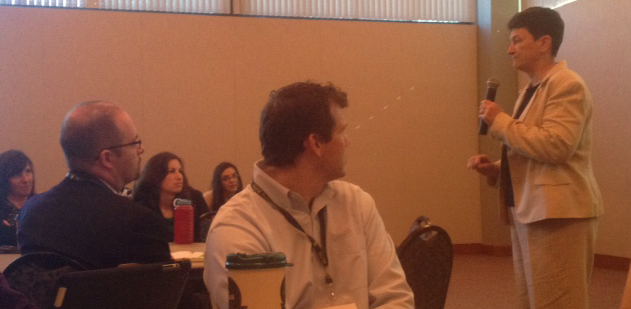“Who cares about campus climate? Why should we care about it?” Dr. Sue Rankin asked her audience Sept. 13 during her talk about building more inclusive communities.
Rankin, now a graduate professor at the Pennsylvania State Graduate School of Education, has been teaching at the university since completing her graduate degree there 36 years ago. For most of her adult life, she has been an advocate for social justice. Her passion for social justice stemmed from her close connection to collegiate athletics.
“I wouldn’t be here without the help of Title IX and my college scholarship,” Rankin said. “I got my graduate degree at Pennsylvania State and was an assistant softball coach, but the second year I was there the coach retired, and so then I was 22 and a Division 1 coach. Gender equality was huge for me at the time.”
Her most recent research has been dedicated to not only targeting problems of campus climate, specifically surrounding LGBT issues, but also solving the problems of inequity among students of color and changing those climates into ones more conducive to healthy, safe and productive students and faculty.
“Many students who identified as being lesbian, gay, bisexual or transgendered were leaving their schools,” Rankin said. “I think it is about the environment and that we are not being supportive there somewhere.”
Rankin began reading up on current literature and found that most students learned better in heterogeneous classrooms, that climate does have a significant impact on student learning and development, and that campus climate and knowledge retention are enhanced by positive perceptions and experiences.
Rankin completed two studies for a side-by-side comparison of progress, one in 2003 and one in 2010, in which there were two large spikes in the number of centers created to help the gay community. The first study was conducted after the torture and murder of a University of Wyoming student Matthew Shepherd, a hate crime committed because he was gay. The second study was conducted after the death of 18-year-old Tyler Clementi, who committed suicide by jumping off the George Washington Bridge after his roommate filmed him with a male partner and posted the footage on the Internet.
These studies sparked her curiosity even further, and Rankin began trying to collect data from college campuses across the United States, polling students on those campuses about how they identified themselves, their level of comfort on campus, whether they had considered leaving their campuses and other questions of that nature.
“While gathering data I realized that there are spectrums in which people can better identify with certain terminology,” Rankin said. “If we strictly use the terminology included in LGBT then we shut out a whole population of people in the transgender spectrum.”
What she discovered about climates on campuses is more surprising with respect to race, not gender. Both people of color and caucasians reported having experienced harassment for their sexual identity or gender identity at similar rates. However, African American, African and Caribbean respondents attributed the harassment to race more than identity.
“There are LGBT people in our society and community, and you interact with them every single day,” Alex Phillips ’14 said. “We all live with each other, and we should be concerned about what is going on with our classmates and colleagues. It is so important to understand why things are the way they are on campus and I think that is the most important thing to consider from [Rankin’s] presentation.”
Many students facing hardships with identifying their sexual or gender identity leave school before they even get to college. One-third of both queer spectrum and trans-spectrum respondents in college said they strongly considered leaving their institutions. Much of this can be attributed to heteronormativity, the assumption that everyone is straight and that all students should conform to society’s heterosexual norms.
There are many substantial issues confronting the gay community today, including the reconciliation of religion and homosexuality, as well as creating available support systems for students, staff and other members of the community.
“I hope that the administration will sort of realize that the only thing they can do is support students and staff. If they can’t do that, they won’t be able to last very long,” Phillips said. “Times are changing and ideas are changing, and things in our society are changing so they [the administration] need to keep up.”
Some available resources for students to seek advice or to advocate issues are the Trevor Project, LGBTQArchitect, Changing the Game, Consortium of Higher Education, Campus Pride and It Takes a Team.
“I think that this is important for William and Mary and for all of us because although there has been increasing visibility around LGBT identity and even increasing acceptance, it is not universal acceptance and there is still a lot of negativity that happens in society,” Assistant Director at the Center for Student Diversity Margie Cook said. “Just the existence of the It Gets Better initiative shows that there is a desperate need for education around LGBT identity because young people are still feeling very drastic effects of lack of acceptance.”
According to Rankin, being well-versed on these ideas can help create a more cohesive community of understanding that expands the constructs of social norms to include every member of the community and excludes no one based on their identity, their sexual preferences, or the way in which they dress, speak or act.
“This just has to stop. LGBT youth are at the highest risk for suicide in our communities,” Rankin said. “We need to create communities of difference. It is not, ‘Where is my space,’ it is, ‘Where is our space together?’”

